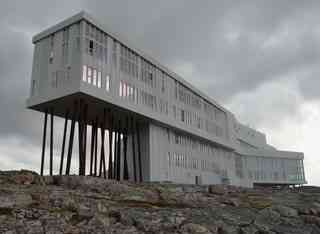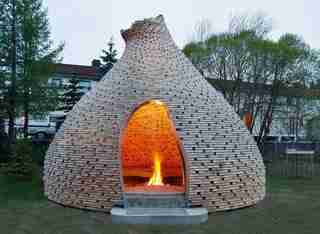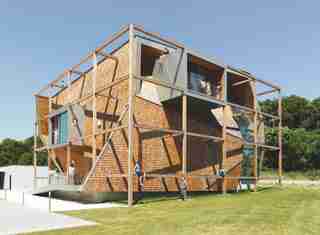The World's 10 Most Incredible Buildings Made Entirely of Wood
At once humble and luxurious, raw and refined, wood—in all its many forms—is surely one of the most versatile materials on the planet. In fact, Wood ( Phaidon , $49.95) is also the apt title of a forthcoming book by William Hall, which pays homage to this natural wonder’s enduring appeal. More specifically it looks at its manifold architectural applications: From a strikingly angular pine heartwood church in the west of Norway to a library facade composed of locally sourced twigs in the countryside near Beijing, the new tome features 170 structures from all around the world that make innovative and beautiful use of timber. The book is thematically structured in chapters like Form, Landscape, and Light, and includes works by some of today’s most notable architects (Sou Fujimoto, Tadao Ando, and Peter Zumthor among them), as well as less widely known contemporary names and late greats like Le Corbusier.

Fogo Island Inn, Fogo Island, Canada, Saunders Architecture, 2013.
Situated on the remote Fogo Island in Newfoundland, the Fogo Island Inn was designed by Saunders Architecture as part of a push to turn this former fishing community into an unexpected architectural destination. The timber hotel was inspired by the simple silhouettes of local cottages and stilted seaside properties.

Fireplace for Children, Trondheim, Norway, Haugen/Zohar Arkitekter, 2010.
The Oslo-based firm Haugen/Zohar Arkitekter built this wooden, igloo-like construct with materials left over from a nearby construction site in the Norwegian city of Trondheim. Intended as an intimate gathering place for fireside storytelling, the project was conceived in response to a brief that sought to create fun environments for local children.

Office Off, Burgenland, Austria, heri & salli, 2013.
The Vienna-based practice heri & salli got creative with this office building in Burgenland, Austria, which unsurprisingly is the HQ of a cladding company. The timber grid that wraps around the structure conveniently doubles as an abseiling tower.
Timber House, Newmarket in der Oberpfalz, Germany, Kühnlein Architektur, 2014.
Composed of two barn-like structures joined in the middle, this private home in Newmarket in der Oberpfalz, Germany, was conceived by Kühnlein Architektur. The entirety of the exterior is covered in untreated larch strips (that will weather to a silvery gray), concealing the home’s windows from the outside while letting daylight through to the inside.
Volga House, Tverskaya, Russia, Peter Kostelov, 2009.
This boxy country house on the banks of the Volga river in Tverskaya, Russia, is clad in wood panels that are angled in seven distinct ways. The Russian architect Peter Kostelov wanted to interpret Soviet era dachas (country houses) in a contemporary way by nodding to the slightly piecemeal sensibility of those historic homes.
Mae Sot Dormitories, Bangkok, Thailand, a.gor.a Architects, 2012.
These low-cost temporary dormitories in Bangkok, Thailand, are part of the Mae Tao Clinic, which offers healthcare and education to refugees of the civil war in neighboring Myanmar. Designed by Thai a.gor.a Architects, the buildings, which house 25 people, are made from locally sourced bamboo, thatch, and recycled timber.
Barn B at Mason Lane Farm, Goshen, KY, USA, De Leon & Primmer Architecture Workshop, 2009.
This striking large-scale shed in Goshen, Kentucky, was designed by the Louisville-based De Leon & Primmer Architecture Workshop. Crafted from locally grown bamboo, the structure is used for seasonal crop storage, and the airy construction allows for plenty of natural ventilation, which is required to dry hay.
Knarvik Community Church, Knarvik, Norway, Reiulf Ramstad Arkitekter, 2014.
Nestled in the Norwegian wilderness, this dramatic angular church by Reiulf Ramstad Architects was constructed with mottled pine heartwood, which comes from the center of a branch or trunk and is known for its durability.
Liyuan Library, Beijing, China, Li Xiadong, 2011.
This library’s unusual twig cladding was inspired by bundles of firewood that the Chinese architect Li Xiaodong noticed during early visits to the site in the countryside near Beijing. The sticks, sourced from local fruit trees, are aligned to allow sunlight to filter through to the interior.
House K, Stockholm, Sweden, Tham & Videgård Arkitekter, 2004.
The firm Tham & Videgård Arkitekter opted for black-stained plywood panels of varying widths to cover the entirety of this moody pine framework house in Stockholm, Sweden.
WOOD by William Hall.